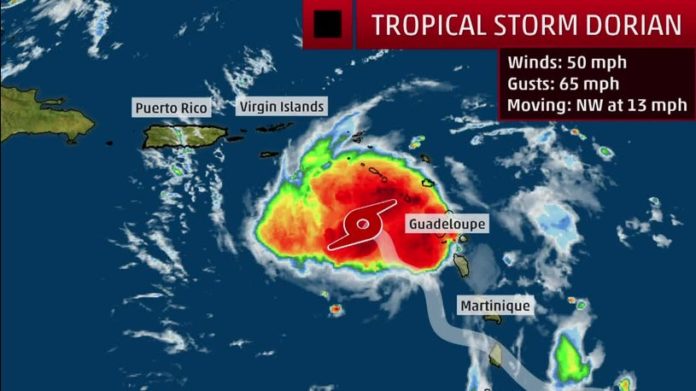
The first bands of rain showered Puerto Rico’s eastern island community, where residents have hunkered down inside their homes bracing for the possible landfall of Tropical Storm Dorian this afternoon in what could be the first major test since the U.S. territory saw widespread suffering and thousands of deaths in the aftermath of the last cyclone to make a direct hit.
Puerto Rico, still recovering from the devastation of Hurricane Maria two years ago, has been watching closely as Dorian’s path shifted northward overnight. Its new trajectory puts it on track to strike Puerto Rico’s eastern coast and the islands of Vieques and Culebra, following a similar path as the destructive Hurricane Maria, according to the National Hurricane Center.
But this is no Maria, which hit the island with Category 4 strength in September 2017, devastating it.
Dorian – still a tropical storm on Wednesday morning, with winds of approximately 70 mph – had slightly diminished in strength overnight and could continue to veer north and pass by the U.S. territory, island officials said. Forecasters expect the storm to threaten the U.S. Virgin Islands and then to strengthen considerably in the Atlantic before taking a turn toward Florida – where it could slam into the state’s northeast coast as a hurricane, perhaps early Monday morning.
The one constant with Dorian has been its unpredictability as it is churns through the warm waters of the Caribbean Sea toward Puerto Rico. The storm’s winds almost certainly will cause some sea surge and lash the island with torrential rain even if it doesn’t make a direct hit.
Puerto Rico’s emergency management commissioner, Carlos Acevedo, said during a news conference early Wednesday that the government expects Dorian to drop between four and 10 inches of rain on the tropical territory. Municipalities are evacuating flood-prone communities in the southeast and along the coast, urging residents to seek refuge in schools serving as temporary shelters.
“We need to focus on the rain,” Acevedo said.
Though forecasters are calling for a relatively tame storm compared with Maria, Puerto Rican officials are preparing for all scenarios. Of particular concern is the possibility of damage to an improving but still vulnerable power grid that is susceptible to frequent outages; authorities also worry about thousands of homes that are still without roofs.
“This is going to be a test,” said Nick Russo, the Federal Emergency Management Agency’s federal coordinating officer in Puerto Rico. “The people of Puerto Rico have been through a lot, and we have learned the lessons of the past.”
Puerto Rico has been recuperating slowly since September 2017, hobbled by delays in federal disaster-aid distribution and major political upheaval in recent months. But officials say it is nowhere near ready for the onslaught of a severe storm because of the damage Maria left in its wake. That hurricane, which engulfed almost the entire island of more than 3 million people, wiped out electric power, compromised water delivery systems and shut down telecommunications. It also exposed failures in emergency preparation and response, with some isolated communities not receiving any sort of help for days.
The changing forecast is triggering warnings that Dorian could have an outsized impact on Puerto Rico’s eastern islands, both of which were hard-hit during Maria and continue to struggle. The mayor of Culebra said in a news release Tuesday ahead of the storm that they are not ready and criticized the central government for poor communications about preparations for an already-vulnerable community. Acevedo said they have since made contact with the leaders on the islands but worry about what the storm could do.
“Conditions have changed rapidly,” Vieques Mayor Victor Emeric said in an interview with Puerto Rico’s Telemundo television station. “All we can do is wait. We need people to shelter in place.”
There were lines at the ATM and grocery store Wednesday morning in Vieques, as people boarded up windows and prepared for the government to shut down the power around noon to prevent injuries with live wires. On the big island, residents were saying that gas stations were running low on fuel for vehicles and generators.
FEMA has positioned 300 people to respond to Dorian and filled five regional warehouses with 10 times as much water, food, blankets and tarps than there was on the island before Maria. Russo said he has been in Puerto Rico since the beginning of hurricane season to oversee preparations and coordinate with the local government. The greatest dangers from Dorian, he said, are from rain and flash floods near and around Puerto Rico’s second-largest city, Ponce – a region that is home to the giant electric generation plants that power the entire territory.
Dorian also could create a critical moment for Puerto Rico’s new territorial governor, Wanda Vásquez Garced. The former justice secretary was sworn into office last month following a political scandal that triggered massive protests and forced Gov. Ricardo Rosselló to resign. The former governor was widely criticized for his government’s handling of Hurricane Maria’s aftermath, specifically in the areas of electrical infrastructure and access to medicine, clean water and reliable health care.
“I can say we are better prepared,” Vásquez Garced said in a statement Tuesday.
The governor has met with federal emergency officials to position backup generators at hospitals and critical institutions, stock up on gasoline, ensure the island’s power utility, PREPA, has enough posts and transformers in inventory, and supply mayors with working satellite phones.
More than 2,000 health professionals were authorized to complete death certificates and document the causes – a move aimed at generating more precise death toll numbers after the Rosselló administration was accused of mishandling the count. For weeks after Maria, the government froze the death toll at about 60, but an estimated 3,000 people died as a result of the storm and its aftermath.
With nearly a third of Puerto Rico’s residents depending on federal food stamps to feed their families, the government was authorized to release monthly benefits ahead of the storm, allowing people to stock up on at least 10 days of supplies should the power go out or if water service is interrupted.
Dorian’s trajectory places worry squarely on Puerto Rico’s power system. The 2017 hurricane largely left the electricity generating plants intact, but the distribution system completely failed. Workers toiled for more than a year to erect and strengthen fallen transmission lines across the central mountains and to install millions of miles of power lines to connect homes to the grid.
The territorial government has signed agreements with public utility contractors in the states and locally, authorizing them to respond immediately with equipment and workers to support the power company’s recovery efforts.
The grid was replaced but has not received the investment needed to make it more resilient because of delays in federal aid, said Angel Figueroa Jaramillo, president of the labor union representing Puerto Rico’s utility workers. Congress has approved $42 billion for the island’s recovery, but only about $14 billion of that has been disbursed, federal data shows. The $8.3 billion in disaster mitigation funding needed for infrastructure projects, such as a water pumping system for flood-prone areas, is moving forward, but it’s unclear when that money will arrive.
“The electric system is not 100 percent recuperated, but it is stronger,” Figueroa Jaramillo said. “But there are vulnerabilities. No one can say how long it will take for the system to recover if the power grid goes down again.”
Daniel Hernandez Morales, director of generation for PREPA, said the utility has deployed more than 400 brigades in strategic locations to respond to potential emergencies and to repair damage. The utility has seven times more resources – $141 million – than it did during Maria. Hernandez Morales said he expects the utility’s structures to withstand tropical-storm-force winds but said flooding could compromise substations and dislodge power lines.
“We are in a better position, and we’ve learned from experience that we have to cover all fronts and have backup plans to our backup plans,” Hernandez Morales said. “Instead of months to restore electricity, we could be talking about weeks.”
Orocovis Mayor Jesús Colón Berlingeri is watching the forecast change by the hour. Projection showed that his central mountain community could be in the cone of impact for Dorian, which could mean landslides, downed trees and flooding. Two years ago, he didn’t have the generators, radios or plans to face the coming storm. But he said his community learned its lesson.
The municipality now has its own public works and disaster response brigades – officials don’t want to rely on the central government to arrive in time to help residents living in remote communities.
“I feel more prepared,” he said. “But each storm is different. We don’t know yet what we’re in for.”
(c) 2019, The Washington Post · Amy Gordon, Jhoni Jackson, Arelis R. Hernández ·
{Matzav.com}











